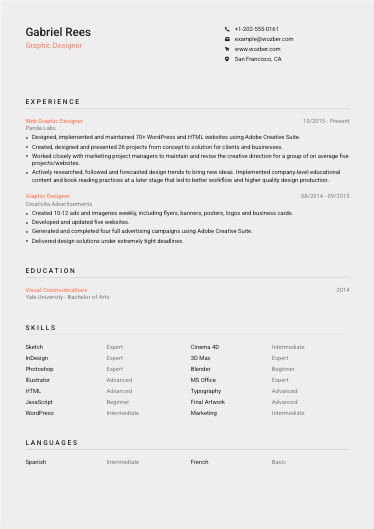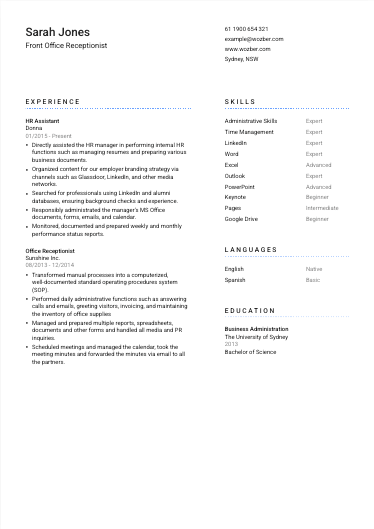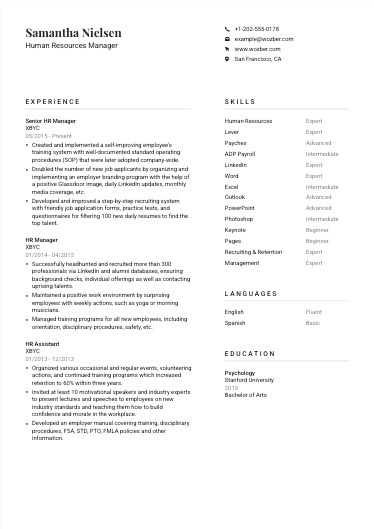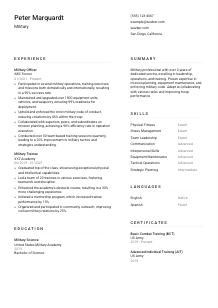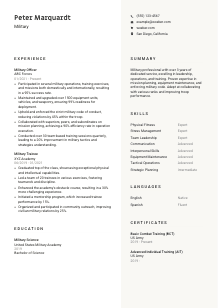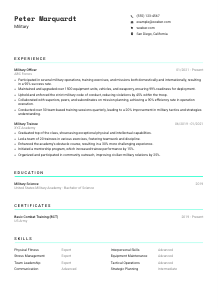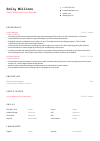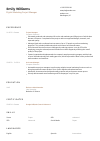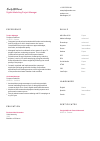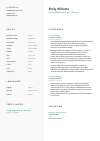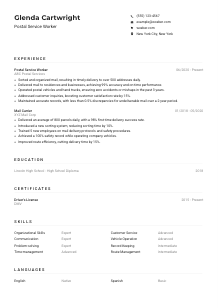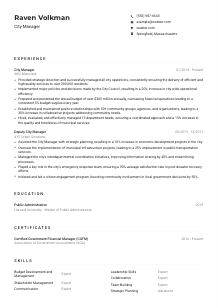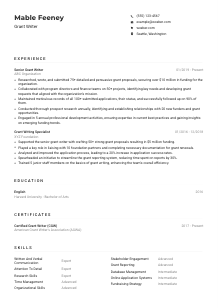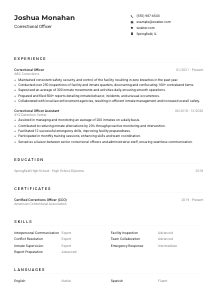Military CV Example
Defending nations but feeling besieged by your CV? Take command with this Military CV example, strategized using Wozber free CV builder. Learn how to deploy your defense skills to correspond with civilian job criteria, marching your career forward with precision and honor.
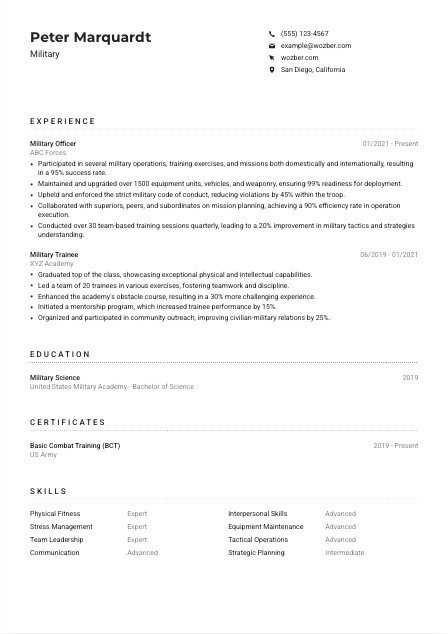
How to write a Military CV?
Greetings, future defender! Crafting a CV for a Military position requires not just attention to detail but a strategic approach to ensure your document passes muster with both human recruiters and the automated gatekeepers known as Applicant Tracking Systems (ATS). Leveraging Wozber, a free CV builder designed with ATS optimisation in mind, this guide will arm you with the tactics needed to create an ATS-compliant CV that shines in the eyes of your future command.
Ready to embark on this mission? March forward to victory.
Personal Details
Kicking off your CV with the Personal Details section is akin to reporting for duty: it needs precision and clarity. Here's how to ensure your personal information is perfectly saluted by potential employers and is in strict formation with the job posting for a Military position.
1. Name as Your Banner
Consider your name the flag you're flying; make sure it's prominently displayed at the top of your CV. Use a clear, bold font that stands at attention, making it impossible to miss.
2. Rank and File
Just below your name, align yourself with the role you're seeking by using the exact job title from the job description. This immediate match demonstrates to the ATS and the hiring manager that you're directly in line with the position of "Military".
3. Communication Channels
List your phone number and a professional email address. Ensure your email is straightforward, utilizing a combination of your first and last name when possible. Typos in contact information are like missing the target—double-check for accuracy.
4. Location Coordinates
"Must be located in or willing to relocate to San Diego, California." Including your current address or indicating willingness to move to San Diego ensures you meet one of the fundamental requirements straight off the bat.
5. Digital Front
If you have a LinkedIn profile or a personal website that showcases your professional accomplishments or Military projects, include it. This digital footprint provides deeper insight into your achievements and readiness for the role.
Takeaway
Your Personal Details section is the beacon that first catches the recruiter's eye. By ensuring this part of your CV is polished and aligned with the Military role requirements, you set a professional tone that carries through the rest of the document. Make this first salute count.





Experience
The Experience section is where you parade your achievements and duties that make you the ideal candidate for the Military position. Let's map out how to maneuver this section to showcase your strategic and operational prowess.
- Participated in several military operations, training exercises, and missions both domestically and internationally, resulting in a 95% success rate.
- Maintained and upgraded over 1500 equipment units, vehicles, and weaponry, ensuring 99% readiness for deployment.
- Upheld and enforced the strict military code of conduct, reducing violations by 45% within the troop.
- Collaborated with superiors, peers, and subordinates on mission planning, achieving a 90% efficiency rate in operation execution.
- Conducted over 30 team‑based training sessions quarterly, leading to a 20% improvement in military tactics and strategies understanding.
- Graduated top of the class, showcasing exceptional physical and intellectual capabilities.
- Led a team of 20 trainees in various exercises, fostering teamwork and discipline.
- Enhanced the academy's obstacle course, resulting in a 30% more challenging experience.
- Initiated a mentorship program, which increased trainee performance by 15%.
- Organized and participated in community outreach, improving civilian‑military relations by 25%.
1. Mission Analysis
Carefully review the job posting, noting key responsibilities and requirements. Highlight experiences from your career that demonstrate your ability to meet these demands, such as "participated in military operations" or "maintained equipment readiness."
2. Campaign Strategy
Organize your professional history in reverse chronological order. Start with your most recent role, ensuring each entry includes your rank (job title), unit (company name), and service dates.
3. Action Reports
For each role, draft bullet points that detail your accomplishments, specifically those that align with the requirements of the Military position. Use action-packed language to bring your duties to life.
4. Victory by Numbers
Whenever possible, quantify your achievements. Be it leading a team through training exercises, improving operation success rates, or maintaining vital equipment, tangible metrics offer a solid proof of your capabilities.
5. Relevance Over Volume
Maintain focus on experiences directly tied to military operations and leadership. Extraneous information dilutes the potency of your CV—keep every bullet point targeted and impactful.
Takeaway
Your Experience section should present a compelling narrative of your military career, with each entry serving as evidence of your qualifications for the targeted role. Let the strength of your background in operations, leadership, and strategic planning be the backbone of your CV. Highlighting these will salute your dedication and readiness for the new role.
Education
The foundation of a strong Military candidate is often laid in the education and training they've undergone. This section will show you how to articulate your educational background in a manner that supports your candidacy for the Military role.
1. Highlighting Strategic Knowledge
First, ensure that your highest level of completed education is clear. While this job doesn't specify a degree requirement, mentioning your Bachelor of Science in Military Science establishes you as well-versed in the discipline.
2. Order of Merit
Keep the layout clean and straightforward. State your major, degree, institution, and graduation year. This structured approach ensures the recruiter can quickly assess your educational qualifications.
3. Mapping your Field of Study
If your degree directly aligns with the Military position, as with a Bachelor in Military Science, make it the centerpiece of this section. This direct correlation flags your CV for both ATS and the human eye.
4. Additional Training and Courses
While not a replacement for traditional education, completing specialized courses or certifications related to your Military Occupational Specialty (MOS) adds depth to your profile. Highlight these to show continuous professional development.
5. Academic Achievements
Finally, if your educational journey includes notable achievements—such as leadership roles in ROTC, academic honors, or relevant extracurricular activities—include these. They further underscore your commitment and potential as a warrior-scholar.
Takeaway
Just as basic training shapes a soldier, your education section shapes the foundation of your CV. It's not merely a list of schools attended; it's a testament to your preparedness for the challenging environments and high-stress situations characteristic of military service. Detailing pertinent education and training underscores your readiness to serve and succeed in this next mission.
Certificates
In the world of military advancement, certifications can act as proof of your specialized training and commitment to continuous growth. Let's strategically position your credentials to reinforce your candidacy for the military role.
1. Target Acquired
Revisit the job description and make a list of desired qualifications. For our example, certifications in Basic Combat Training (BCT) and Advanced Individual Training (AIT) are specifically mentioned. These should be highlighted prominently in your CV.
2. Selective Fire
Prioritize listing certifications that directly relate to the Military position's requirements. This conciseness ensures the hiring manager instantly sees your applicable qualifications without needing to dig through unrelated information.
3. Time on Target
For each certification, include the date of completion to provide a timeline of your professional development. This transparency shows your trajectory and readiness for the operational demands of the role.
4. Continuous Reload
The military field evolves rapidly, requiring continuous learning and adaptation. Display your dedication to remaining professionally sharp by pursuing ongoing education and updating your certifications as necessary.
Takeaway
Think of your certificates as medals on the uniform of your CV—they catch the eye and speak volumes about your expertise and dedication. Make sure each one you list directly serves your mission of landing the Military position. Keeping this section updated and relevant showcases your commitment to excellence and preparedness.
Skills
Your skills section is a rapid-fire overview of your capabilities. Here's how to load it with the ammunition needed to target the Military position, ensuring it resonates with both the ATS and the hiring manager.
1. Intelligence Gathering
Start by dissecting the job description to identify both the explicit and implied skills required. Skills such as physical fitness, stress management, and tactical operations should be on your radar.
2. Laser Focus
List skills that match those required by the job posting. Including expertise in equipment maintenance, strategic planning, and leadership not only aligns with the job requirements but also demonstrates your multifaceted capability.
3. Formation
While it's tempting to showcase a wide range of skills, concentrate on those most relevant to a Military role. This strategic selection ensures your CV is potent and to the point, making it more effective.
Takeaway
Your skill set is your personal arsenal—make sure it's well-equipped and ready for the challenges of a Military role. Tailoring this section to the job's demands demonstrates your strategic acumen and readiness to contribute meaningfully. Remember, in the battle for a job, precision is key.
Languages
In the modern Military, the ability to communicate across cultures and languages is increasingly crucial. Here's how to highlight your linguistic capabilities in a way that underscores your readiness for international missions.
1. Call to Action
"Must have the ability to speak and understand English fluently." Clearly, fluency in English is a non-negotiable requirement. Position this at the forefront of your Languages section, emphasizing your mastery.
2. Strategic Selection
If you know additional languages, list them in order of relevance to the Military role or the regions you may be deployed in. This shows not just your linguistic skills but your awareness of where they might be applied in service.
3. Rank and File
For each language, clearly state your level of proficiency. Whether it's native, fluent, intermediate, or basic, this clarity helps the hiring manager gauge where you could be best deployed.
4. Global Operator
Each language you speak is a testament to your ability to operate in a global context, an increasingly valuable asset in modern military operations. Emphasize languages that expand your operational reach.
5. Tactical Communication
Understanding the strategic value of your languages within a military context can give you an edge. Languages relevant to current or potential areas of operations are particularly beneficial to highlight.
Takeaway
Your ability to speak multiple languages positions you as a valuable asset for any operations needing nuanced communication and cultural insight. Highlighting this skill set not only showcases your professional capabilities but also your personal dedication to embracing and understanding a global community. Stand at ease, knowing your linguistic proficiency is a powerful ally in your career advancement.
Summary
Your CV's Summary is the opening volley, setting the tone for what follows. It's your chance to capture the essence of your military career and why you're the top candidate for the position. Let's refine your approach to ensure it's sharp and on target.
1. Reconnaissance
Take the time to fully absorb the job description. Understanding the mission requirements inside-out will help you calibrate your summary precisely.
2. Engagement
Begin with a strong opening statement that captures your military career in a nutshell. Highlight your years of service, your core specialties, and any notable operations or achievements.
3. Tactical Highlights
Pinpoint the most critical skills and experiences that align with the job's requirements. This could range from your proven leadership in high-stress environments to your adeptness in maintaining operational readiness.
4. Precision
Keep your summary concise and impactful. Aim for a brief, powerful paragraph that encapsulates your suitability for the Military role, leaving the hiring manager eager to read on.
Takeaway
Well executed, your Summary should salute your career achievements and readiness for the role at hand, all while capturing the recruiter's attention. It sets the strategic framework for the rest of your CV, highlighting your mission-critical experiences and skills. Consider it your personal battle cry—make it resonate.
Launching Your Mission
Congratulations on completing your mission briefing. With your CV now crafted for battle using Wozber's free CV builder, including an ATS-friendly CV template and ATS optimisation tools, you're ready to engage. Remember, each section of your CV is a coordinated maneuver designed to capture your target: the job. As you venture forth, keep honing your skills, updating your achievements, and adapting your strategies.
The path to victory in your career is a relentless pursuit of excellence. Deploy your CV with confidence and await your next mission orders. Godspeed.

- Minimum of 2 years prior military service or relevant work experience.
- Must be physically fit and able to pass the Military Physical Fitness Test.
- Strong communication and interpersonal skills.
- Ability to work under high-stress situations and in challenging environments.
- Completion of Basic Combat Training and Advanced Individual Training (specific certifications/licenses may vary by Military Occupational Specialty).
- Must have the ability to speak and understand English fluently.
- Must be located in or willing to relocate to San Diego, California.
- Participate in military operations, training exercises, and missions both domestically and internationally.
- Maintain equipment, vehicles, and weaponry to ensure readiness for deployment.
- Uphold strict adherence to the military code of conduct, regulations, and policies.
- Collaborate and communicate effectively with peers, superiors, and subordinates in daily operations and mission planning.
- Conduct regular self and team-based training sessions to stay updated on military tactics and strategies.

